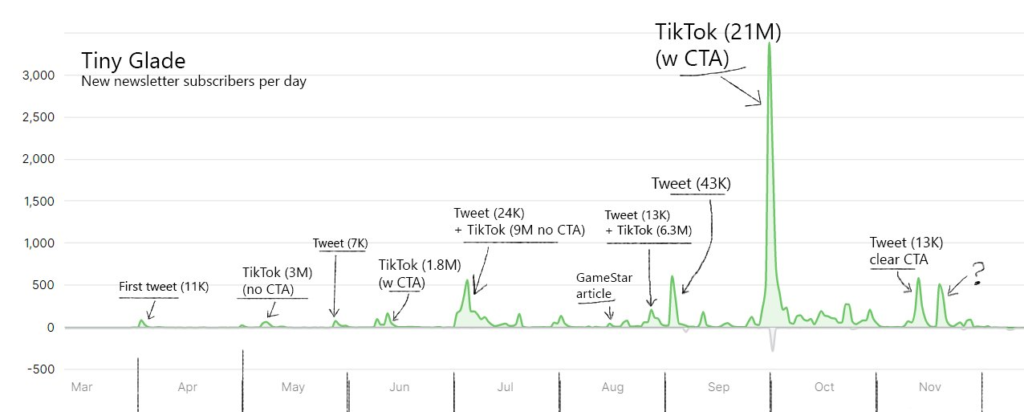But first a word from the author
This Thursday July 13th I am launching version 2.0 of my Wishlist & Visibility Master class. Here is a preview of the new class.
The new version will launch at a deep discount. So you should definitely pick it up when it goes on sale.
If you already own Wishlist & Visibility Masterclass 1.0 you don’t need to do anything. All the content will automatically update on Thursday. You don’t need to buy anything more.
To make sure you don’t miss the launch of the discount, sign up for my mailing list here.
Twitter troubles
Twitter has been having a moment the past couple weeks and people wonder how they are going to promote their games if they can no longer tweet about it. In today’s blog I want to talk about how games actually earn visibility and how they get those 1000s of wishlists.
Twitter is a small part of visibility
I was curious about how twitter drama is impacting traffic from twitter and I did a very informal survey of some past clients and friendly devs and found that Twitter accounted for just 0.08% – 1.78% of the total traffic a game gets. These numbers are the same for boring months when the developers are between major promotions and during the month of their big launch when they are sharing their game everywhere.
For most games twitter engagement is very bad. Just a dozen or so retweets, a handful of comments. It doesn’t go anywhere.

Then there are games that are so beautiful a single tweet can go viral. These are the magical beautiful games. Some of these games are so photorealistic they attract attention, but they can also be stylistic or adorable. Sometimes even ugly games that are visually striking can go viral; the French call this Jolie Laide. I can’t define what makes a game twitter friendly, it just happens. Some games have the magic when it comes to being visually interesting. There is just something when you see it. I recently wrote about Tiny Glade which was able to get 100s of news letter signups with only a tweet:

But even with these visually beautiful games, Twitter is not the primary driver of traffic… Steam is. Wait what?
Why you pay steam 30%
If you can make a video game, you are more than smart enough to put together a website, add Stripe payment processing, and sell your game directly to consumers. No more 30% share going to Steam, you get to keep everything (minus a small credit card processing fee.)
So why not do that?
Because Steam can give you so much more visibility than you could ever generate yourself. The trick is you have to prove to them that your game is worth it. If you can prove to the Steam algorithm that your game is worth promoting, Valve takes over and shares your game to millions of people who love spending money on video games. That is why you pay Valve 30%.
Unfortunately, you need to first prove it to Valve and the way you do that is by bringing a ton of external traffic to your Steam page. Valve uses this external traffic as a signal that your game has something that is worth promoting.
Twitter is one such “external” source. So if you can get your game to go viral on Twitter, then link to your Steam page, Valve will notice that and start sharing your game to more people. It usually does this via widgets like More Like This and Discovery Queue. But it is hard, very few games are interesting enough to go viral. That is why Valve uses that as a signal that a game is worth promoting.
The good news is Twitter isn’t the only source of external traffic. In fact it isn’t even the best. Here are other sources:
- Streamer (youtube/twitch) playing your demo / game
- A viral Reddit post
- Getting IGN to post your trailer (I wrote more about how to get covered by IGN here)
- Tiktok
- A big festival such as PC Gamer, Game Awards, or Summer Game Fest
Those are just a few examples of huge traffic sources that count as “external.”
External traffic is just the start of the journey
I have seen a lot of indies complain that after they got covered by a streamer they got thousands of views but only earned a couple sales.
This is the wrong way of looking at it.
The value the streamer brings is that they trigger the algorithm, drive wishlists so Valve starts promoting you. Then, the next time your game is discounted, those wishlisters buy it.
Think of it like this.
You use external promotion to start the chain of dominos that tells the Steam algorithm that you are worth of promoting. It isn’t immediate. It is a multi step process.
Not all games are built for Twitter
Not all games are built for Twitter however. If you have a deep, strategic, building, crafting game, with graphics that are functional but not amazingly beautiful, you probably won’t go viral on Twitter. It just isn’t that type of game. But you can get that necessary external traffic through other means such as releasing a demo and getting streamers to play it.
This phenomenon explains how thousands of people buy a game despite the developer having a tiny following on Twitter. The Steam algorithm did the promotion for them. There are multiple ways to do this.
The moral of the story.
So yes Twitter is exploding. No it isn’t that bad. There are lots of ways to trigger the algorithm.
The one thing that Twitter is good at is networking so you can meet other developers out there. I wrote about this here.
Good luck out there.
Also don’t forget to check out my big sale where all my courses will be going on Sale in July.